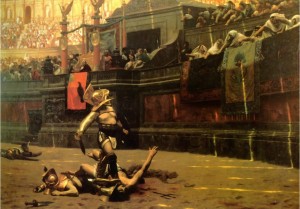Art Movements of 2000s: Classical Realism
Classical Realism
Classical Realism refers to an artistic movement in late 20th century painting that places a high value upon skill and beauty, combining elements of 19th century neoclassicism and realism.

Jean-Léon Gérôme. Pollice Verso (1872). Classical Realism traces it lineage from Gérôme.
Origins
The term “Classical Realism” was originally used in the title of a 1982 exhibition by Richard Lack (1928 – 2009), a pupil of R. H. Ives Gammell(1893-1981). The movement traces its lineage from Jean-Léon Gérôme (1824-1904) through William Paxton (1869-1941) of the Boston school.
By 1985 Richard Lack had begun publishing Classical Realism Quarterly, with articles written by Lack and his students, aiming to inform the public about traditional realist painting.
In a separate vein, another major contributor to the revival of traditional drawing and painting knowledge is the painter and art instructor Ted Seth Jacobs (1927 – ), who taught students at the Art Student’s League and the New York Academy of Art in New York City. Their lineage is rooted in the Académie Julian, the Golden Age of Illustration in New York, and the School of Paris. In 1987 Ted Seth Jacobs created his own art school, L’Ecole Albert Defois in Les Cerqueux sous Passavant, France (49). Many of Jacobs’ students such as Anthony Ryder and Jacob Collins became influential teachers and acquired their own student following.
Style and philosophy
Classical Realist style is characterized by a love for the visible world and the great traditions of Western art, including Classicism, Realism and Impressionism. The movement’s aesthetic is Classical in that it exhibits a preference for order, beauty, harmony and completeness; it is Realist because its primary subject matter comes from the representation of nature based on the artist’s observation. Artists in this genre strive to draw and paint from the direct observation of nature, and eschew the use of photography or other mechanical aids. In this regard, Classical Realism differs from the art movements of Photorealism and Hyperrealism. Stylistically, classical realists freely borrow techniques from both Impressionism andAcademic art.
Classical Realist painters have attempted to revive methods of artistic training and techniques that pre-date Modern Art. To this end, they seek to create paintings with a high degree of craftsmanship. Popular subject matter within this genre includes figurative and still life paintings.
A central idea of Classical Realism is the belief that the Modern Art movements of the 20th century caused a disruption in the understanding of art production as it was first conceived in the Classical period, resurrected in the Renaissance, and carried down through the academies to the nineteenth and early twentieth centuries. Classical Realist artists attempt to revive the idea of art production as it was traditionally understood: mastery of a craft in order to make objects that gratify and ennoble those who see them. This craftsmanship is then applied to drawing, painting or sculpting contemporary subjects which the artist observes in the modern world.
Like the 19th century academic models from which it derives inspiration, the movement has drawn criticism for the premium placed upon technical performance, a tendency toward contrived and idealized depictions of the figure, and rhetorical overstatement when applied to epic narrative. Maureen Mullarkey of the New York Sun referred to the school as “a contemporary style with retro appeal— like Chrysler’s PT Cruiser”.
Source: en.wikipedia.org.com


This Post Has 0 Comments